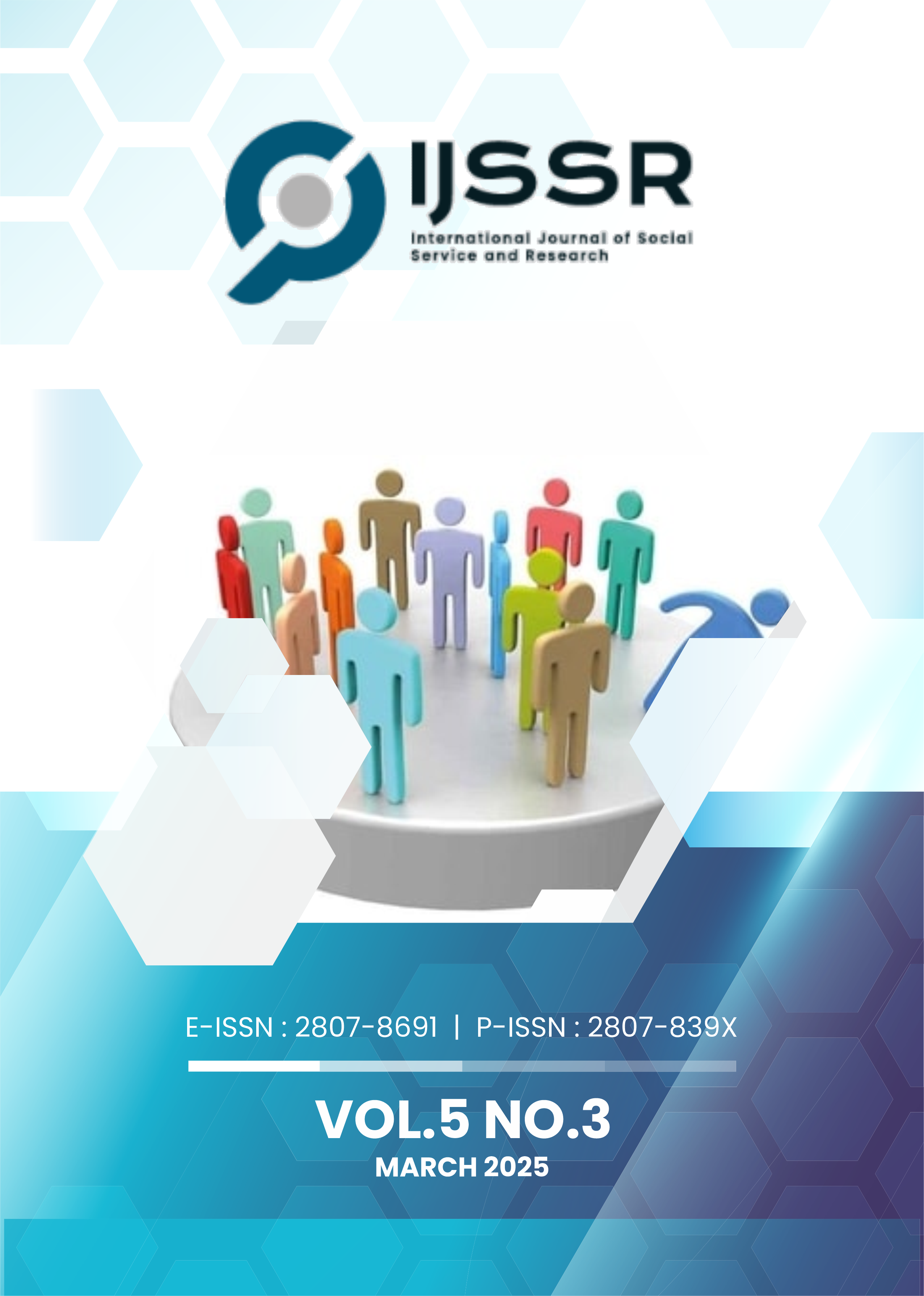ANALYSIS OF FINANCIAL SYSTEM STABILITY IN INDONESIA: A PRINCIPAL COMPONENT ANALYSIS APPROACH
DOI:
https://doi.org/10.46799/ijssr.v5i3.1208Keywords:
banking financial institutions, financial markets, financial system stability, principal component analysisAbstract
This study uses Principal Component Analysis (PCA) to analyze the stability of Indonesia's financial system using 15 indicators from banking financial institutions and financial markets. The PCA technique is applied to each variable included in the components of bank financial institutions or non-bank financial institutions into several main factors that have the same variant value. The first principal component (PC1) successfully captured around 38 percent of the total variability and became the dominant indicator for financial system stability in Indonesia. In addition, from the banking financial institution indicators, NIM and LDR became factors that had quite an influence on PC1, indicating that profitability and banking intermediation activities still played a role in the dynamics of financial system. Furthermore, the interplay between Credit Default Swaps (CDS), exchange rates, and stock market indicators like the IHGS could provide deeper insights into how these elements influence investor sentiment and overall financial stability. Therefore, more comprehensive policy steps are needed to strengthen the resilience of the financial system, including stabilizing the bond market, managing exchange rate risk, and strengthening monetary and macroprudential policies to face future economic uncertainty.
References
Agapova, A., & McNulty, J. E. (2016). Interest rate spreads and banking system efficiency: General considerations with an application to the transition economies of Central and Eastern Europe. International Review of Financial Analysis, 47. https://doi.org/10.1016/j.irfa.2016.07.004
Agung, J., & Juhro, S. M. (2016). Managing monetary and financial stability in a dynamic global environment: Bank Indonesia’s policy perspectives. BIS Paper, 88.
Angori, O. C. (2013). The Regularization of Undocumented Immigrants in the United States: The Spanish Solution. Eur. JL Reform, 15, 80.
Asian Development Bank. (2021). The Bond Market in Indonesia. Asian Development Bank.
Basci, E., & Kara, H. (2011). Financial Stability and Monetary Policy.
Buchory, H. A. (2023). Banking Profitability: How do the banking intermediary, secondary reserve, operational efficiency, and credit risk effect? GATR Journal of Finance and Banking Review, 8(2). https://doi.org/10.35609/jfbr.2023.8.2(1)
Carmichael, J., & Pomerleano, M. (2002). Development and Regulation of Non-Bank Financial Institutions. In Development and Regulation of Non-Bank Financial Institutions. World Bank Publications. https://doi.org/10.1596/0-8213-4839-6
Christiani, A., & Lisai, R. O. (2019). MACROPRUDENTIAL AND MICROPRUDENTIAL POLICY IN THE PERSPECTIVE OF LAW NUMBER 21 OF 2011. Justitia et Pax, 35(2). https://doi.org/10.24002/jep.v35i2.2434
Crockett, A. (2020). Why is financial stability a goal of public policy? Handbook of Monetary Policy. https://doi.org/10.4324/9780429270949-4
Fajriani, N., & Sudarmawan, B. (2022). Microprudential Policy in Maintaining Bank Stability. Journal of Economics, Finance And Management Studies, 05(06). https://doi.org/10.47191/jefms/v5-i6-18
Gharaibeh, A. M. O. (2023). The Determinants of Capital Adequacy in the Jordanian Banking Sector: An Autoregressive Distributed Lag-Bound Testing Approach. International Journal of Financial Studies, 11(2). https://doi.org/10.3390/ijfs11020075
Gunadi, I., Taruna, A. A., & Harun, C. A. (2013). Penggunaan Indeks Stabilitas Sistem Keuangan (ISSK) Dalam Pelaksanaan Surveilans Makroprudensial. In Working Paper Bank Indonesia (15; Bank Indonesia Working Paper, Vol. 15).
Idris, M. (2023). Mengenal OJK, Sejarah Berdiri, Tugas, Fungsi, dan Wewenangnya. Kompas.
Indrawan, I. W., Rahman, M. P., & Senusi, N. A. (2020). FINANCING-TO-VALUE (FTV) POLICY AND ITS IMPACT ON RESIDENTIAL PROPERTY PRICES IN INDONESIA. Journal of Islamic Monetary Economics and Finance, 6(3). https://doi.org/10.21098/jimf.v6i3.1176
Kidwell, D. S., Blackwell, D. W., Whidbee, D. A., & Sias, R. W. (2016). Financial institutions, markets, and money. John Wiley & Sons.
Koroleva, E., & Kopeykin, M. (2022). Understanding of Macro Factors That Affect Yield of Government Bonds. Risks, 10(8). https://doi.org/10.3390/risks10080166
Pacces, A. M. (2013). Illiquidity and financial crisis. University of Pittsburgh Law Review, 74(3). https://doi.org/10.5195/lawreview.2013.260
Prasaja, F. X. (2023). OPINI: Kebijakan Bank Indonesia untuk Menjaga Stabilitas Suhu Sistem Keuangan. Bisnis.Com.
Ratner, M., & Chiu, C. C. (2013). Hedging stock sector risk with credit default swaps. International Review of Financial Analysis, 30. https://doi.org/10.1016/j.irfa.2013.05.001
Simanjuntak, M. H. (2024). BI Perkuat Bauran Kebijakan Dukung Pertumbuhan Ekonomi Berkelanjutan. Antara News.
Simarmata, G. M. (2013). Indonesia’s Rupiah and Capital Market Correlation Risk Study for Macroprudential Policy to Prevent Systemic Risk. SSRN Electronic Journal. https://doi.org/10.2139/ssrn.2346024
Sugandi, E. A. (2022). Indonesia’s Financial Markets and Monetary Policy Dynamics Amid the COVID-19 Pandemic. Asia-Pacific Financial Markets, 29(3). https://doi.org/10.1007/s10690-021-09354-4
Susilowati, F., & Purnama, H. (2022). Bank Performance Based on Core Capital Amid the COVID-19 Pandemic in Indonesia. KnE Social Sciences. https://doi.org/10.18502/kss.v7i14.12031
Wahyudi, C. A., & Arbay, E. A. (2021). The Impact of OJK Regulation No. 48/POJK.03/2020 the Quality of Credit and Risk Management of Banking Credit. Journal of Economics and Business, 4(1). https://doi.org/10.31014/aior.1992.04.01.332
Wakidah, A. (2021). Peran Bank Indonesia dalam Stabilitas Sistem Keuangan di Indonesia. Tirto ID.
Warjiyo, P. (2017). Indonesia: The Macroprudential Framework and The Central Bank’s Policy Mix. BIS Paper, 94(94).
Widiarti, A. W., Siregar, H., & Andati, T. (2015). THE DETERMINANTS OF BANK’S EFFICIENCY IN INDONESIA. Buletin Ekonomi Moneter Dan Perbankan, 18(2). https://doi.org/10.21098/bemp.v18i2.520
Wiratmini, N. P. (2020). Perjalanan 9 Tahun OJK, Kilas Balik Fungsi Pengawasan Terintegrasi. Bisnis.Com.
Xie, W., Ye, C., Wang, T., & Shen, Q. (2020). M&A goodwill, information asymmetry and stock price crash risk. Economic Research-Ekonomska Istrazivanja , 33(1). https://doi.org/10.1080/1331677X.2020.1773893
Downloads
Published
Issue
Section
License
Copyright (c) 2025 I Gede Putu Wahyu Brianala Genta Putra, I Nyoman Mahaendra Yasa

This work is licensed under a Creative Commons Attribution-ShareAlike 4.0 International License.
Authors who publish with this journal agree to the following terms:
- Authors retain copyright and grant the journal right of first publication with the work simultaneously licensed under a Creative Commons Attribution-ShareAlike 4.0 International. that allows others to share the work with an acknowledgement of the work's authorship and initial publication in this journal.
- Authors are able to enter into separate, additional contractual arrangements for the non-exclusive distribution of the journal's published version of the work (e.g., post it to an institutional repository or publish it in a book), with an acknowledgement of its initial publication in this journal.
- Authors are permitted and encouraged to post their work online (e.g., in institutional repositories or on their website) prior to and during the submission process, as it can lead to productive exchanges, as well as earlier and greater citation of published work.













